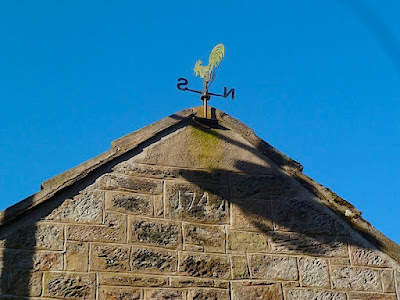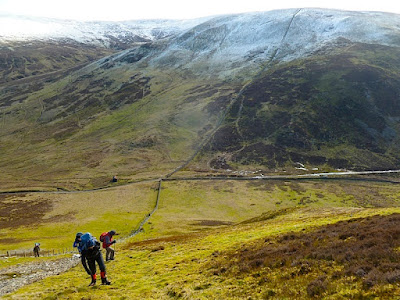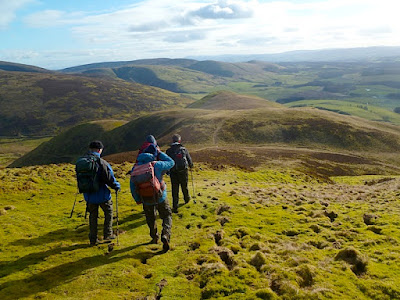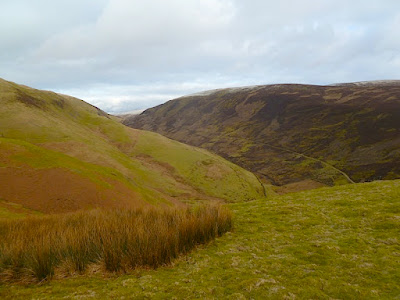'How these curiosities would be quite forgot, did not such idle fellowes as I put them down.'
- John Aubrey
Welcome to my wee photoblog on Glasgow, where we feature the joys and unjoys of walking and cycling through a fascinating, beautiful and often badly run city. For the blog's origin and a list of all posts see the 'Introduction' post -
http://glasgowalbum.blogspot.com/2010/02/introduction.html
Today is Sunday, 19 February, 2012, and we are off to walk the Lowther Hills above Durisdeer in the Borders.
 |
| Heading towards the Lowther Hills. |
 |
| There are 33 names on the memorial - the men who left in WWI and never returned. |
 |
From the Undiscovered Scotland site linked above -
' The biggest surprise in Durisdeer is its Parish Church, built on a scale out of all proportion to the village itself. This is explained by Durisdeer's role as parish kirkton for Drumlanrig, covering the castle and large estates of the Dukes of Queensberry to the north west.
There has been a church on this site since medieval times. In 1719 it was largely demolished and during the 1720s the church you see today appeared in its place. Inside you find a T-shaped church with a large pulpit at its focal point, box pews, and galleries in all three "wings". ' |
 |
| Let's go for a wander in the churchyard |
 |
| The earliest 'skull and crossbones' tombstones are to be found in Scotland |
 |
| A jaunty figure |
 |
| Graveyards are often places of long shadows |
 |
'Who is the third who walks always beside you?
When I count, there are only you and I together
But when I look ahead up the white road
There is always another one walking beside you
Gliding wrapt in a brown mantle, hooded
I do not know whether a man or a woman
—But who is that on the other side of you?'
- The Waste Land |










 |
These flowers are I, poor Fanny Hurd,
Sir or Madam,
A little girl here sepultured.
Once I flit-fluttered like a bird
Above the grass, as now I wave
In daisy shapes above my grave,
All day cheerily,
All night eerily!
-- I am one Bachelor Bowring, 'Gent',
Sir or Madam;
In shingled oak my bones were pent;
Hence more than a hundred years I spent
In my feat of change from a coffin-thrall,
To a dancer in green leaves on a wall,
All day cheerily,
All night eerily!
-- I these berries of juice and gloss,
Sir or Madam,
Am clean forgotten as Thomas Voss;
Thin-urned, I have burrowed away from the moss
That covers my sod, and have entered this yew,
And turned to clusters ruddy of view,
All day cheerily,
All night eerily!
-- The Lady Gertrude, proud, high-bred,
Sir or Madam,
Am I -- this laurel that shades your head;
Into its veins I have stilly sped,
And made them of me; and my leaves now shine,
As did my satins superfine,
All day cheerily,
All night eerily!
-- I, who as innocent withwind climb,
Sir or Madam,
Am one Eve Greensleeves, in olden time
Kissed by men from many a clime,
Beneath sun, stars, in blaze, in breeze,
As now by glowworms and by bees,
All day cheerily,
All night eerily!*
-- I'm old Squire Audeley Grey, who grew,
Sir or Madam,
Aweary of life, and in scorn withdrew;
Till anon I clambered up anew
As ivy-green, when my ache was stayed,
And in that attire I have longtime gayed
All day cheerily,
All night eerily!
-- And so these maskers breathe to each
Sir or madam
Who lingers there, and their lively speech
Affords an interpreter much to teach,
As their murmurous accents seem to come
Hence hitheraround in a radiant hum,
All day cheerily,
All night eerily! |




 |
| The door into the Queensbury Mausoleum - we'll go in when we come off the hill |
 |
| We'll take a wee walk round the rest of Durisdeer |
 |
| We'll be heading up there shortly for the walk |
 |
| Let's have a wee look inside the kirk |
 |
| Scottish presbyterian kirks have their own spare beauty |
 |
| The road we came in - we will visit the graveyard down there on the left later |
 |
| Missing dog |
 |
| Durisdeer Toon |
 |
| Wald Path to Troloss March - a direction out of The Lord of the Rings |
 |
| We are tagging along with a party of ramblers led by our friend Ian |
 |
| My deceased father in law - John MacKenzie - has the same verse on his Portree tombstone |
 |
| We are now heading up the Roman Road in the Dalveen Pass, a route that was ancient when the Romans arrived. |
 |
| We are branching to the left |
 |
| Looking back |
 |
| Looking back |
 |
| We are going through here - note MOD mark on stone |
 |
| Ice patterns |
 |
| Approaching the Roman fortlet |
 |
The Roman Fortlet. To quote Undiscovered Scotland (link above):
'When the Romans came this way they built their road between Nithsdale and Clydesdale on a more direct route than taken by today's A702. It went through the Dalveen Pass to the north east of Durisdeer, a route that took it right through the site of today's village.A mile or so along a track north east of Durisdeer you find the site of a Roman fortlet, one of the best preserved in Britain with protective ramparts and ditch still visible.' |

 |
The view a Roman soldier would have had.
'Over the heather the wet wind blows,
I've lice in my tunic and a cold in my nose.
The rain comes pattering out of the sky,
I'm a Wall soldier, I don't know why.
The mist creeps over the hard grey stone,
My girl's in Tungria; I sleep alone.
Aulus goes hanging around her place,
I don't like his manners, I don't like his face.
Piso's a Christian, he worships a fish;
There'd be no kissing if he had his wish.
She gave me a ring but I diced it away;
I want my girl and I want my pay.
When I'm a veteran with only one eye
I shall do nothing but look at the sky.'
- 'Roman Wall Blues', Auden |
 |
| A shed is great for peeing behind, but when you turn round there will be figures on the nearest ridge laughing at you |
 |
| Or coming up behind you |
 |
| Nearing the saddle and a cup of Darjeeling |
 |
| A death trap for small mustellids on left - this is working country |
 |
| On the pass saddle. The sign says Wald Path To Durisdeer 2 Miles |
 |
| We will shortly be heading up the ridge |
 |
| Homes for wee creatures; they'll be glad of the mustellid traps |
 |
| A false horizon - the bane of the weary hillwalker |
 |
| The Dalswinton Wind Farm in the distance |
 |
| Ramblers tend to dislike wind farms. I am not so sure. The trouble with wind farms, alas, is that many in the business - and many politicians - are telling porkies |
 |
Note the tracking station on the top of the highest hill on right (will have close up later). From wiki:
http://en.wikipedia.org/wiki/Lowther_Hills#Dalveen_Pass
'Green Lowther is the highest hill in the whole Lowther Hills area and like Lowther Hill it has a Civil Aviation Authority aircraft tracking station on top of it. The huge white ball on the top of Lowther Hill can be seen from many miles away in all directions. The Southern Upland Way passes over the top of Lowther Hill.' |
 |
| Looking back |
 |
| The views are lovely but we must press on |
 |
| Solway Firth glimmering up there on left: you can often see the Lake District from here |
 |
| This stretch reminds me of a broad bit of the Trotternish Ridge (oh what a tiring walk that is) |
 |
| Lovely rolling hills; tracking station in distance |
 |
| Looking back |
 |
| Another pit stop |
 |
| Pressing on |
 |
| Last hill for today in view |
 |
| Let's try a telephoto of the tracking station. Hold breath. . . |
 |
| . . .Not bad. Have to say again, what lovely hills |
 |
| An early caterpillar |
 |
| Trig point |
 |
| Heading down, spring in step |
 |
| Good view of the fortlet from here |
 |
This is the route the Border Reivers took to get to Glasgow's back door. People assume the threat to the central belt came from the north, from the Highlands, but the deeper and longer lasting threat came from the borders. Not usually from the English either, oh no. The Dalveen Pass links Nithsdale with Clydesdale, and through this ancient route flowed desperadoes as malign as any baddy in a spaghetti western, moving north in a storm of murder and theft.
Thanks to George MacDonald Fraser's magnificent history of the Border Reivers, The Steel Bonnets (1971), the Archbishop of Glasgow's 1524 curse against the depredations of the Border reivers has become once again well known. The bishop of Glasgow was one Gavin Dunbar ( c.1490-1547), and he himself was not a significant addition to the general well-being of 16th century Scotland. He was made archbishop by Pope Clement VII, the Medici pope whose bungling and cruelty did so much to damage the prestige of the church. Dunbar did his best to live down to his pope's beliefs, and had Protestants burned at the stake. His 'Monition of Cursing' Against the Border Reivers is one of the greatest cursers ever issued., It begins
"Gude folks, heir at my Archibischop of Glasgwis letters under his round sele, direct to me or any uther chapellane, makand mensioun, with greit regrait, how hevy he beris the pietous, lamentabill, and dolorous complaint that pass our all realme and commis to his eris, be oppin voce and fame, how our souverane lordis trew liegis, men, wiffis and barnys, bocht and redeimit be the precious blude of our Salviour Jhesu Crist, and levand in his lawis, are saikleslie part murdrist, part slayne, brynt, heryit, spulziet and reft, oppinly on day licht and under silens of the nicht, and thair takis and landis laid waist, and thair self banyst therfra, als wele kirklandis as utheris, be commoun tratouris, ravaris, theiffis, dulleand in the south part of this realme, sic as Tevidale, Esdale, Liddisdale, Ewisdale, Nedisdale [Nithsdale] , and Annandereaill; quhilis hes bene diverse ways persewit and punist be the temperale swerd and our Soverane Lordis auctorite, and dredis nocht the samyn.
His magnificent curse had little effect alas. For the full text see my Curses blog -
http://buddhasblackdog.blogspot.com/2011/09/historical-curses-1-monition-of-cursing.html
And for a fine modern translation see -
http://www.scotlandgenweb.org/berwickshire/History/cursing2.htm |








 |
| Note Highland cow in disguise |
 |
| Note what looks like little trackway - is this for water to run off? Man made? I know so little of the country |
 |
| Whatever it is, it runs for a fair bit |
 |
| One of the Ramblers spots something exciting on the bird feeders. . |
 |
| Snow buntings |
 |
| That tombstone looks as if it has a menacing face |
 |
| We're going to pop into the Queensbury Mausoleum for a wee look |
 |
| Note old door weathering into wall |
 |
| Another skull with (I think) cross bones |
 |
| We're now at Durisdeer Cemetry |
 |
| The grave of Ian's friend, Elspeth, died 2008. Rest in peace Elspeth |
 |
| Buccleuch Estates. Scotland may change in appearance, but the thrones, dominions and powers remain |
 |
| Driving back to Glasgow; weather closing in |
Feel free to drop me an email with suggestions, offers of £20 notes etc. The address is damnyouebay@gmail.com
My other wee blogs are
http://parkeddogs.blogspot.com/
http://buddhasblackdog.blogspot.com/
Reviews of
Scotland: 1000 Things You Need to Know
RADIO AND TELEVISON
'I love it - I'm giving this copy to a friend and buying another for
myself' - Darren Adam, Presenter, Radio Forth, 17 November 2008
‘It’s a great wee book’ – Stephen Jardine, introducing Edwin Moore on Scottish Television’s Five-Thirty Show
'A fantastic book' - Scott Wilson , talk 107 Breakfast Show host
'A great read' - Dougie Jackson, Drivetime host, Smooth Radio 105.2
THE PRESS
'Despite its apparently humorous format, this is a serious and extensive
dictionary on all things Scottish; from Jean Redpath to Lorne sausage,
from Flodden to the Corries. Is particularly good on history and
minutiae. There's a useful chapter on famous Scottish legal cases and
another on literature. Excellent' - Royal Scottish Legion, Feb 2009
'This is the ultimate Scottish reference book' - Waterstones Christmas catalogue, 2008
'This is a fascinating look at the history of Scotland: its languages,
politics and great achievements, from its origins in the ancient
landmass of Laurentia 400 million years ago, to devolution and Billy
Connolly. Edwin Moore has collected a thousand important facts about
this beautiful country, covering Scottish history and culture,
correcting misconceptions, and examining the mysteries of haggis and
bagpipes with insight, warmth and impressive attention to detail' - The
Good Book Guide, November 2008
'This is a recipe for revealing how horribly ill informed you are about
your country. Although, if you are skillful, you can nod sagely as you
read some new fact and mutter 'Ah, yes!' as if recalling the information
from your excellent schooling. Where else will you find a real recipe
for making haggis from scratch side by side with a potted biography of
David Hume; a section of the Declaration of Arbroath and the curiously
touching fact that Lulu was only 15 when she had a hit with 'Shout'? The
whole thing is of course, silly - but oh so addictive.' - Matthew
Perren, i-on Glasgow, December 2008
'. . . well crafted and witty' - Bill Howatson, Aberdeen Press and Journal, 18 October 2008
‘While most of Edwin’s entries are entertaining and scholarly – he
writes like a Scottish Bill Bryson – it is when he takes an interest in
the backwaters of history, the details lost down the back of the sofa,
that he is at his best’ – Jack McKeown, The Courier, 27 October 2008
'History, it is said, is written by the victors. Trivia, meanwhile, is
written by the guys with the smeared spectacles and the breathable
rainwear. The first discipline is linear and causal; to quote from Alan
Bennett’s play The History Boys, history is “just one f****** thing
after another”. Things look different, though, when viewed through the
prism of trivia. The past is reduced to one big coleslaw of fascinating
facts that in their randomness tell a more mixed-up tale entirely.
The first approach leads to big, frowning books by the likes of Tom
Devine and Michael Fry. The latter results in small, cheerful books such
as Scotland: 1,000 Things You Need to Know, Edwin Moore’s valiant
attempt to navigate the more trivial contours of enlightenment and
clearances, crown and parliament, dirt and deity.
Moore proceeds from a sincere and controversial first principle:
Scotland is really a rather pleasant and interesting place. . .As a work
of popular scholarship, though, it’s in a different league to the
Scottish novelty titles that get stocked next to the bookstore tills as
potential impulse purchases, those little handbooks of parliamo
Caledonia and regional braggadocio, such as Weegies vs Edinbuggers.' -
Allan Brown The Sunday Times, 21 September 2008
'In his book, Scotland: 1000 Things You Need to Know, Edwin celebrates
all that sets us Scots as a race apart - our language, law, flora, food,
and of course, our people. From our poets, architects and inventors, to
our artists, entertainers and fighters. But he doesn't shy away from
the more unpleasant aspects of our history. . .' - Robert Wight, Sunday
Post, 14 September 2008
‘We think we know all about William Wallace, Robert the Bruce and the
Union of the Crowms. However, according to Edwin Moore, author of ,
Scotland: 1000 Things You Need to Know, we’re still in the dark about
many aspects of our history and culture. . . The Big Issue looks at 20
of the most astonishing examples of secret Scotland.’ – The Big Issue,
18-24 September 2008
'What's the connection between Homer Simpson and Larbert, and why are
generations of lawyers grateful to a Paisley snail? Need to know more?
Author Edwin Moore has gathered 1000 facts like these about Scotland in a
quirky new book. Brian Swanson selects a few favourites. . .' -
Scottish Daily Express, 13 September 2008
'The palm for Christmas-stocking books seems to have passed recently to
popular science, with best selling titles every year such as Why Don’t
Penguins’ Feet Freeze? This year there has been a gallant attempt at a
historical fight back. Scotland: 1,000 Things You Need to Know(Atlantic
Books, £12.99) asks (and answers) such post-turkey questions as ‘How
many kings of Scotland died in their beds?’, ‘Who on earth decided that
the Declaration of Arbroath was the cornerstone of modern democracy?’ or
‘Why is iron brew spelled Irn-Bru?’ Mark Mazower,History Today; The
Best of History in 2008, December 2008
'A real treat for the serendipitous Scotophile' - Reginald Hill
FROM THE INTERWEB
www.Booksfromscotland.com (on the new paperback edition)
Book of the Month, May 2010
'Whether it's Scottish lochs or Enlightenment philosophers, the facts of
the devolution referendums or the mysteries of Irn-Bru, myths will be
debunked and truths revealed in this light-hearted but rigorous overview
of Scottish history and culture.'
Also available for download on Amazon's e-book store is my 100 Brief Encounters (only £3.06!)
http://www.amazon.co.uk/100-Brief-Encounters-ebook/dp/B006CQ8G84/ref=sr_1_1?s=books&ie=UTF8&qid=1322393003&sr=1-1
Here are some reviews of the print edition (published by Chambers in 2007) -
Edwin Moore's quirky collection of a hundred encounters between (mostly)
important historical figures is a gem of a book. Where else could you
get concise enlightening accounts of Henry VIII wrestling with Francis
I, Geronimo surrendering to General Miles, Ernest Hemingway presenting
Fidle Castro with a fishing trophy or (as seen on the books cover) a
baby faced Bill Clinton shaking hands with John F Kennedy. A marvelous
'little window on human history. ' - Dominic Kennerk, Waterstone's
Product Planning and Promotions Co-ordinator (From the Waterstone's 'We
Recommend' list for 2008)
Witty, light and packed with information -- The Sunday Herald
In 1936, in the wake of winning a clutch of gold medals at the Berlin
Olympics, the great athlete Jesse Owens was snubbed by an imperious
leader, on racial grounds. Popular belief would have it that the leader
was Hitler, who is said to have stormed off, furious to see a black man
beating European athletes. In fact the man in question was President
Roosevelt, who worried that paying attention to Owens' triumphs might be
a vote loser. Although Owens and the German Chancellor never talked,
Owens claimed that Hitler greeted him with an enthusiastic wave. Such
near-misses, shakings of hands and ships-in-the-night meetings are the
subject of Brief Encounters – Meetings between mostly remarkable people,
a likeable new book by Edwin Moore (Chambers £7.99). Flicking through
the index, you will find some expected encounters (Dante stares at
Beatrice, Corday stabs Marat, The Beatles strum along to a Charlie Rich
record round at Elvis's house), and the book's intriguing and memorable
cover shows a baby-faced Bill Clinton manfully gripping the hand of JFK.
But Moore has navigated past some of the more obvious collisions,
collusions and confrontations of history (there is no Dr Livingstone, I
presume) and much of the book's pleasure derives from lesser known
incidents.
Inevitably, some of the accounts of earlier meetings are somewhat
sketchy but Moore offers some piquant speculation, laced with humour
(the book is tagged Reference / Humour, rather than History and this
feels right, but the book, though wry and opinionated, never stoops to
wackiness). I was intrigued to discover that, though Attila the Hun did
die on his wedding night, it was not in drunken and lecherous
debauchery, as his enemies maintained, but supposedly because he was
generally a simple and clean-living man who had a few too many which
brought on a particularly bad nosebleed.
Moore's book is full of such tales – it would be wrong of me to steal
the tastiest morsels of his research and pepper this article with them,
but look out for a subsidiary reason for the Gunpowder Plot (too many
dour and powerful Scots in Parliament); a great meeting of great beards,
as Castro wins the Hemingway prize for sea-fishing; Dali bringing a
skeptical Freud round to the art of the surrealists; Buffalo Bill's wife
claiming an aged Queen Victoria had propositioned him; Oscar Wilde
getting a kiss from Walt Whitman, while Walter Scott was more taken with
Burns's charismatic eyes. This is an enjoyable and vigorous rattle
through some fascinating and believable yarns. My only quibble is that
it's a little on the short side – let's have Volume 2 please Chambers! -
Roddy Lumsden, www.Books from Scotland.com












































































































































































































































































"The trouble with wind farms, alas, is that many in the business - and many politicians - are telling porkies"
ReplyDeletedo tell, Eddie ...
(from someone in the business)
Ah thanks Stewart - I should have said in the 'energy business' - including nuclear, coal, etc as well as renewables. When there is so much money flying about then porkies will be flying about also.
DeleteI heard a ding-dong argument the other week on Radio Scotland between a turbine manufacturer and a farmer and I reckon both were sailing pretty far beyond the bounds of veracity!
My own no doubt not worth very much opinion is that we need renewables (inc. wind farms)- and will need them more - but when so much is at stake (and so many jobs) my first reaction on any energy claim is always the Paxman politcian one, 'why is this bastard lying to me'.